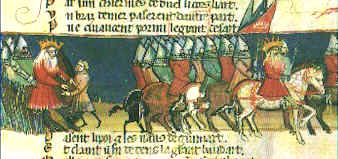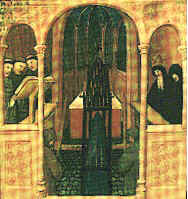Two Descriptions of the Battle of Roncesvalles
This illustration from a fourteenth-century manuscript of the The Song of Roland (or Chanson de Roland) shows Charlemagne embarking with his army on the conquest of Spain. |
Einhard At a time when this war against the Saxons was being waged constantly and with hardly an intermission at all, Charlemagne left garrisons at strategic points along the frontier and went off himself with the largest force he could muster to invade Spain. He marched over a pass across the Pyrenees, received the surrender of every single town and castle which he attacked and then came back with his army safe and sound, except for the fact that for a brief moment on the return journey, while he was in the Pyrenean mountain range itself he was given a taste of Basque treachery. Dense forests, which stretch in all directions, make this a spot most suitable for setting ambushes. At a moment when Charlemagne’s army was stretched out in a long column of march, as the nature of the local defiles forced it to be, these Basques, who had set their ambush on the very top of one of the mountains, came rushing down on the last part of the baggage train and the troops who were marching in support of the rearguard and so protecting the army which had gone on already The Basques forced them down into the valley beneath joined battle with them and killed them to the last man. They then snatched up the baggage, and, protected as they were by the cover of darkness, which was just beginning to fall, scattered in all directions without losing a moment. In this feat the Basques were helped by the lightness of their arms and by the nature of the terrain in which the battle was fought. On the other hand, the heavy nature of their own equipment and the unevenness of the ground completely hampered the Franks in their resistance to the Basques. In this battle died Einhard, who was in charge of the King’s table, Anshelm, the Count of the Palace and Roland, Lord of the Breton Marches, along with a great number of others. What is more, this assault could not be avenged there and then, for, once it was over, the enemy dispersed in such a way that no one knew where or among which people they could be found. |
Here Charlemagne mourns at the tomb of Roland, in another elaborate fourteenth-century manuscript of The Song of Roland.
It is interesting that the story of Roland was still popular more than five hundred years after the Battle of Roncesvalles (or Roncevaux). |
The Carolingian Chronicle 778 AD The Lord King Charles marched to Spain by two different routes.’ One was by Pamplona, which the great king himself took as far as Saragossa. To Saragossa came his men from Burgundy, Austrasia, Bavaria, as well as Provence and Septimania, and a part of the Lombards. Arriving from two sides the armies united at Saragossa. The king received hostages from ibn al-Arabi and Abu Taher and many Saracens, destroyed Pamplona, and subjugated the Spanish Basques and the people of Navarre. Then he returned to Francia. On the heights of the Pyrenees the Basques prepared an ambush, attacked the rearguard, and threw the whole army into confusion. Although the Franks were obviously their betters in arms and valor, they nevertheless suffered a defeat due to the unfavorable terrain and the unequal method of fighting. In this engagement a great many officers of the palace, whom the king had given positions of command, were killed; the baggage was plundered, and the enemy was able to vanish in all directions because he knew the lay of the land. To have suffered this wound shadowed the king’s view of his success in Spain. |

